It has been suggested that this article be merged into Immaculate Heart of Mary . (Discuss) Proposed since September 2022. |
The Scapular of the Immaculate Heart of Mary is a Roman Catholic devotional scapular. [1]
It has been suggested that this article be merged into Immaculate Heart of Mary . (Discuss) Proposed since September 2022. |
The Scapular of the Immaculate Heart of Mary is a Roman Catholic devotional scapular. [1]
This white scapular originated in 1877 with the Sons of the Immaculate Heart of Mary (Claretians). [2] It was sanctioned and endowed with indulgences by Pope Pius IX in May 1877. The scapular was later approved by the Congregation of Rites in 1907 and assigned indulgences. [3]
The scapular is made of white fabric and the front has an image of the burning heart of Mary, out of which grows a lily; the heart is encircled by a wreath of roses and pierced with a sword. [4] [2] A Crux immissa or an image of Mater Misericordiæ appears on the reverse.

The Sacred Heart, also known as the Sacred Heart of Jesus or Most Sacred Heart of Jesus, is one of the most widely practised and well-known Catholic devotions, wherein the heart of Jesus is viewed as a symbol of "God's boundless and passionate love for mankind". This devotion to Christ is predominantly used in the Catholic Church, followed by high-church Anglicans, Lutherans and some Western Rite Orthodox. In the Latin Church, the liturgical Solemnity of the Most Sacred Heart of Jesus is celebrated the third Friday after Pentecost. The 12 promises of the Most Sacred Heart of Jesus are also extremely popular.

The scapular is a Western Christian garment suspended from the shoulders. There are two types of scapulars, the monastic and devotional scapular, although both forms may simply be referred to as "scapular". As an object of popular piety, it serves to remind the wearers of their commitment to live a Christian life.
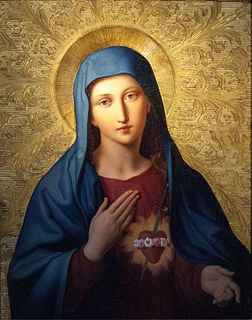
The Immaculate Heart of Mary is a Roman Catholic devotional name used to refer to the Catholic view of the interior life of Mary, mother of Jesus, her joys and sorrows, her virtues and hidden perfections, and, above all, her virginal love for God the Father, her maternal love for her son Jesus Christ, and her motherly and compassionate love for all mankind. Traditionally, the Immaculate Heart is depicted pierced with seven swords or wounds, in homage to the seven dolors of Mary and roses, usually red or white, wrapped around the heart.

Our Lady of Mount Carmel, or Virgin of Carmel, is the title given to the Blessed Virgin Mary in her role as patroness of the Carmelite Order, particularly within the Catholic Church. The first Carmelites were Christian hermits living on Mount Carmel in the Holy Land during the late 12th and early to mid-13th century. They built in the midst of their hermitages a chapel which they dedicated to the Blessed Virgin, whom they conceived of in chivalric terms as the "Lady of the place." Our Lady of Mount Carmel was adopted in the 19th century as the patron saint of Chile.
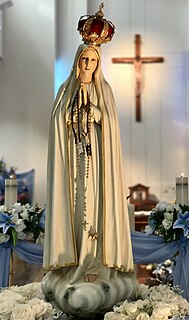
The Blue Army of Our Lady of Fátima, now mostly known as the World Apostolate of Fátima, is a public international association of the Christian faithful that has as its general purpose "the promotion of the authentic teaching of the Roman Catholic Church and the strict adherence to the tenets of the Gospel; the personal sanctification of adherents through faithful adherence to the Message of Our Lady of Fátima and the promotion of the common good by the spreading of that Message of Fátima".

The Miraculous Medal, also known as the Medal of Our Lady of Graces, or Our Lady of The Miraculous Medal is a devotional medal, the design of which was originated by Saint Catherine Labouré following her apparitions of the Blessed Virgin Mary in Rue du Bac, Paris, France. It was made by goldsmith Adrien Vachette.

Catholic devotions are particular customs, rituals, and practices of worship of God or honour of the saints which are in addition to the liturgy of the Catholic Church. The United States Conference of Catholic Bishops describes devotions as "expressions of love and fidelity that arise from the intersection of one's own faith, culture and the Gospel of Jesus Christ". Devotions are not considered part of liturgical worship, even if they are performed in a church or led by a priest, but rather they are paraliturgical. The Congregation for Divine Worship at the Vatican publishes a Directory on Popular Piety and the Liturgy.
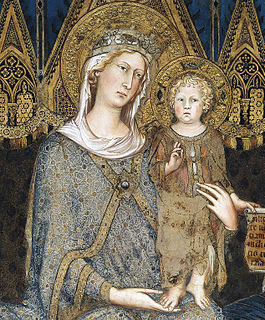
The veneration of Mary, mother of Jesus, in the Catholic Church encompasses various devotions which include prayer, pious acts, visual arts, poetry, and music devoted to the her. Popes have encouraged it, while also taking steps to reform some manifestations of it. The Holy See has insisted on the importance of distinguishing "true from false devotion, and authentic doctrine from its deformations by excess or defect". There are significantly more titles, feasts, and venerative Marian practices among Roman Catholics than in other Western Christian traditions. The term hyperdulia indicates the special veneration due to Mary, greater than the ordinary dulia for other saints, but utterly unlike the latria due only to God.

The Black Scapular of the Passion is a Roman Catholic devotional scapular associated with the Passionists.
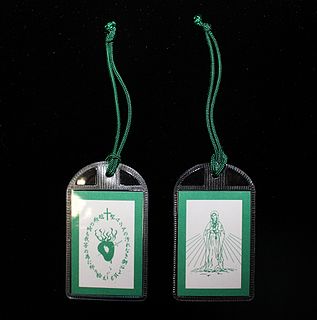
The Green Scapular is a Roman Catholic devotional article approved by Pope Pius IX in 1870. It is called a scapular due to its appearance, but is not descended from the scapulars that form part of the habit worn by religious orders. It can be more accurately described as a "cloth medal". It is unique among Catholic scapulars, as it the only scapular which has only one badge of cloth, while all others have at least two.

The exact origins of both the rosary and scapular are subject to debate among scholars. Pious tradition maintains that both the rosary and the brown Scapular of Our Lady of Mount Carmel were given by the Virgin Mary to Dominic and Simon Stock respectively during the 13th century. Historical records document their growth during the 16th and 17th centuries in Europe. By the early 20th century, they had gained such a strong following among Catholics worldwide that Josef Hilgers, writing in the Catholic Encyclopedia of 1914, stated: "Like the Rosary, the Brown scapular has become the badge of the devout Catholic."

The Blue Scapular of the Immaculate Conception is a devotional scapular that traces its roots to Venerable Ursula Benincasa, who founded the Roman Catholic religious order of the Theatine Nuns. This scapular must have a blue woollen cloth and on one side bears a symbolization of the mystery of the Immaculate Conception of Our Lady and on the other the name of the Blessed Virgin Mary.

The Scapular of the Sacred Heart is a Roman Catholic devotional scapular bearing an image of the Sacred Heart of Jesus on the front panel, and an image of the Virgin Mary as Mother of Mercy on the panel which hangs at the wearer's back. In its current form, the design and the formal church approval for its use are due to Estelle Faguette, a French domestic servant, who in 1876 claimed to have received a series of apparitions during which the Virgin Mary showed this scapular and spoke about its use.

The Scapular of Saint Joseph is a Roman Catholic devotional scapular that traces its roots to the Order of Friars Minor Capuchin in St. Claude in France and was initially in white. It was later approved for the Diocese of Verona by the Congregation of Rites in 1880. In 1898, Pope Leo XIII granted the Capuchins the right of blessing and investing this scapular.

The Scapular of the Seven Sorrows of Mary is a Roman Catholic devotional scapular that dates back to the thirteenth century. It is worn by members of the Confraternity of the Seven Dolours of Mary, associated with the Servite Order.

The Scapular of Our Lady of Mercy is a Roman Catholic devotional scapular that traces its roots to the Order of the Blessed Virgin Mary of Mercy also known as Our Lady of Ransom which was founded by St. Peter Nolasco in the city of Barcelona, at that time in the Kingdom of Aragon, for the redemption of Christian captives.

The Scapular of the Sacred Hearts of Jesus and Mary is a Roman Catholic devotional scapular approved at the request of the Archbishop of Marseilles, by the Congregation of Rites in 1900.

The Scapular of St. Dominic is a Roman Catholic devotional scapular. This scapular was approved by St. Pope Pius X in 1903.

The Scapular of Help of the Sick is a Roman Catholic devotional scapular originating in 1860.
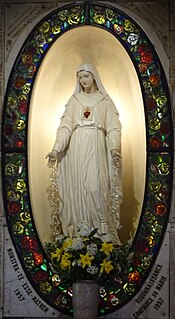
Our Lady of Pellevoisin is a title of the Blessed Virgin Mary which refers to a series of Marian apparitions in Pellevoisin, in the province of Berry, in the department of Indre, France. Pellevoisin is west of Châteauroux in the Catholic Archdiocese of Bourges.